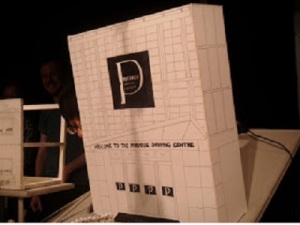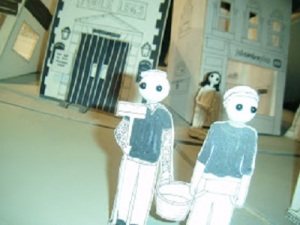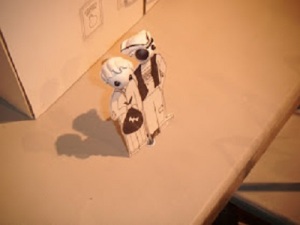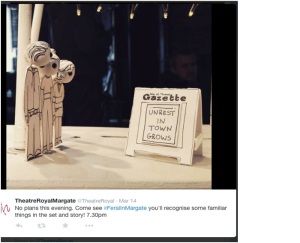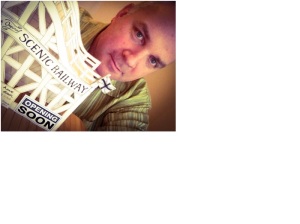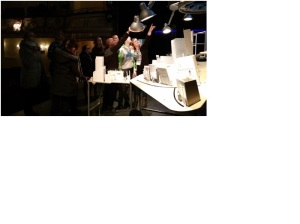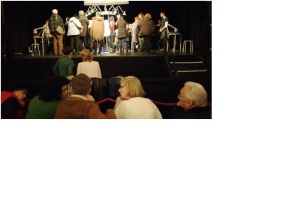I’ve just done a bit of reorganising on this blog: not a redesign, because I’m technologically quite lazy and unexpectedly fond of its bubblegum pink; more a gentle rethink of how each post is categorised (goodbye argument, hello thinking – more friendly, no?). Apart from other usefulnesses, the exercise made me realise how little attention I’ve paid on here to a really important strand of New Theatre in Your Neighbourhood: the commissioning of new or adapted work specifically for one or more of NTiYN’s participating towns. It’s a story that has developed slowly and emerged piecemeal, through a series of really interesting and heartening events, each one demonstrating how vital this strand has been.
Some of those events have been responsive: Fuel encountered a work one place, and proposed producing it as part of NTiYN in another. Such was the case with Daniel Bye’s Story Hunt, which he made in association with ARC in Stockton-on-Tees: it begins with Dan spending a few days in a town, gathering stories of people’s lives and local events, and ends with a walking tour, in which Dan relates those stories back to the audience, weaving them with historical knowledge and an invigorating reminder that a town’s life and future depends on its people – and can be changed for the better by its people. Fuel loved the premise and programmed the work in Margate; I was at the Theatre Royal recently for a performance of a new show by Dan, Going Viral, and people in the audience afterwards said they had come because they had enjoyed Story Hunt and wanted to see more of him. Bingo!
Similarly, Fuel saw Tortoise in a Nutshell’s Feral – a live-animation puppet show set in a fading seaside town – in a concrete box at the Edinburgh festival, and instantly recognised that it would sit perfectly in two actual seaside towns, Margate and Poole. They invited the company to remake Feral specifically for those two places, giving them research and development time to redesign bits of the set and a few of the characters to reflect recognisable local landmarks and public individuals. In both instances, audience numbers far exceeded expectation – and, when I saw the show in Poole, it was gorgeously clear from instinctive vocal responses what a difference it made to everyone in the room that what they were seeing had been made with them in mind. In each place, locals were invited to make their own films to be screened before the performances, creating a lively conversation between different views of the areas, different art forms, different experiences.
It’s there in the title of The Preston Bill who that work was commissioned for. And the story of how it came to be made is itself emblematic. It began just over two years ago, with Andy Smith taking a tour of Preston as part of a series of Artists’ Missions – reconnaissance visits from a motley set of artists to the NTiYN towns, time spent getting a feel for the place, finding out about its identity, its people, its secret nooks and crannies, and thinking about a work that could be made in response.
Andy’s record of his day in Preston contains so many germs of The Preston Bill: the story of a man, in the industrial north, told with a left-leaning political slant; a man who has a very particular relationship to education and learning, who works for BAE – it’s fascinating to look back over the Mission text and images and, with hindsight, see in them clues to the contents of Andy’s play. I saw The Preston Bill in two places in the south while it was still in development: in Margate, where older men in the audience talked fascinatingly about the ways in which their lives did and didn’t intersect with Bill’s, and asked each other and Andy how they felt about the character, whether or not they sympathised with him; and in London, by which time Andy had introduced a big old “power in the unions” singalong that gave me goosebumps. Seeing it in Preston for the first time at the end of October, I was struck by the oddness of Andy’s opening lines: in this room, in this theatre, we can be both here and in the North, in a town called Preston. But we are in Preston!, the logical-realist bit of my brain cried. That statement felt so vibrant and magical in the south, simultaneously holding us in the room and transporting us elsewhere; in Preston, it felt obtrusive.
But that’s me quibbling. Other quibbles emerged in the post-show discussion: one man, for instance, took umbrage at Andy’s inauthentic pronunciation of Bracciano’s, name of a famous local cafe. But there was also pride: that this was a story of and from a town that should have stories told about it, that should be on the cultural map. And there was sadness: at the demise of industrial employment for working people in the area, the lack of apprenticeships, the diminishing of opportunity. I love that this single show was able to inspire such polarised discussion; that, in telling a seemingly simple story, it invites a complexity of response.
To accompany the Preston performances, Fuel also commissioned two local artists, Garry Cook and Toni-Dee Paul, to create their own short works. I caught Garry’s and it was a fascinating complement to Andy’s play: a series of photographs juxtaposing world events from the past 80 years with scenes of town/city and domestic life in Preston, slow-moving at first then erupting with rambunctious energy as Instagram took over. It made me think about how history is documented, represented and retold, what makes up a life, what impacts on a life – and how our lives today will be remembered 80 years from now.
The Preston Bill is the only finished work to have emerged from the Missions so far, but I don’t think that’s surprising: a one-man show which prides itself on having no set, no complicated lights, no touring requirements – literally, all Andy needs is his ukulele, and a chair which he finds in the venue – The Preston Bill is about as lo-fi as theatre gets, and even that took just over two years to be “finished”. Other works, by Sylvia Mercuriali (for Malvern) and Abigail Conway (for Poole) have, like so much in theatre, not come to fruition because of scheduling issues. I think more work will be born of NTiYN, and in the meantime, the Missions documents are entertaining, astute and often beautiful works of art in their own right. The artists – very few of whom already had a working relationship with Fuel – were invited to represent their visit on this blog as they chose, and they did so with text and images distinctive and characteristic in their focus and lens.
The one other work to emerge directly from the Missions wasn’t a commission: it was created by Slung Low five years ago and has been quietly popping up around the country ever since. The Knowledge Emporium is an alternative economy, a celebration of community, a sideshow and a compendium of stories in one. The premise is quite simple: Slung Low pitch up in a town in an air-stream caravan and spend a week inviting people to share their knowledge in exchange for sweets. At the end of the week, the performers read the knowledge back to the town in the time it takes to make a tortilla. Two years ago, Slung Low’s artistic director Alan Lane went on two Artists’ Missions: to bustling Colchester, which has four theatres of its own, and to nearby Jaywick, which is completely off the theatre touring radar. Fuel could have asked him to take the Emporium to Colchester: it certainly would have been easy; instead, they paved the way for a stint in Jaywick, which finally happened last month. Alan’s account of the week is one my favourite things I’ve ever published on this blog: it’s sad, and honest, and fierce, not least in its commitment to art that makes space for people’s voices to be heard. It’s one of the best things to come out of NTiYN, and it happened almost invisibly.
As part of the wrapping-up work on NTiYN, I’ve been interviewing other producers, theatre companies and artistic directors about their approaches to its questions around audience engagement; transcripts and a synthesising essay will be published here over the coming weeks. In one conversation, Vicky Featherstone talked about the vital role within the National Theatre of Scotland of community-specific programming, and how exciting she found the challenge of creating work that speaks directly to a social group or a building or a locale or an identity. And maybe it could be argued that all theatre aims to do this: but in that strand of NTS and this strand of NTiYN, that aim is foregrounded and explicit.
I’ve struggled from the beginning with the ways in which NTiYN can be interpreted cynically as a hyper-inflated marketing exercise; but at its best heart, its gestures are more generous than that. What I love about all the works I’ve gathered here is how giving they are: the lengths they go to give people, communities, a chance to see and hear themselves; the different ground they tread to do so.
